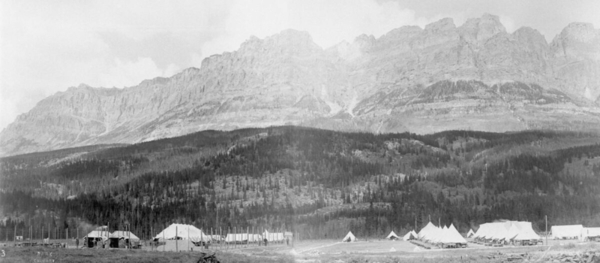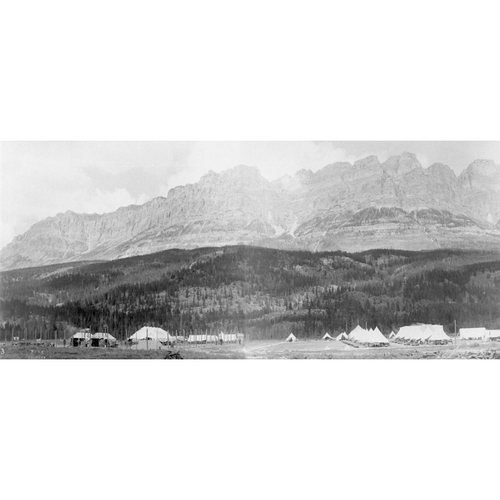
Source: Link
PERCHALUK, WILLIAM (Wasyl Perchaliuk), labourer, internee, and soldier; b. c. 1891 in Dereniowka (Ukraine); d. 5 Dec. 1916 in Calgary.
William Perchaluk was among the more than 170,000 Ukrainians, primarily from the Austro-Hungarian empire, who came to Canada prior to World War I as agricultural settlers and industrial labourers. He became one of the 5,954 immigrants from Austria-Hungary confined in Canadian receiving stations and internment camps during the war. There they built roads, erected and repaired buildings, and cleared and drained land. Although intended to house unnaturalized enemy aliens who had contravened regulations or were security threats, the camps in practice held the destitute and unemployed. Nativist pressure and prejudice were also factors through which individuals, some of them naturalized British subjects, ended up in the camps. As the majority of internees posed no threat to security, by 1916 most had been paroled back into the labour force.
Perchaluk had been initially interned at Lethbridge, Alta, and he was transferred on 19 July 1915 to Castle Mountain in the Rocky Mountains (Banff) National Park. Here over 600 internees worked between 1915 and 1917 on various projects, including the construction of the Banff to Lake Louise motorway. On 26 June 1916 Perchaluk and 25 others were paroled to work for the Canmore Coal Company. In late November he enlisted as a private in the 211th Infantry Battalion at Calgary. The battalion had entered Camp Sarcee for training in July, but a shortage of recruits necessitated a last-minute campaign to bring it to full strength and Perchaluk was part of this drive. On 2 December, during the excitement surrounding the battalion’s impending departure for Europe, Perchaluk was arrested. Having been recognized by an officer from the Banff internment camp, he was confined in the Calgary police station and charged “as an alien enemy joining overseas forces.” Constable George Millen noted that Perchaluk was in uniform, “spoke broken English,” and was rumoured to be “an escaped prisoner of war from Detention camp Castle Mountain.”
On the evening of the 5th, the day after the 211th Battalion left Calgary, Perchaluk was found hanging by the neck from a puttee fastened to his cell bars. He was cut down and given first aid prior to the arrival of a physician, who tried unsuccessfully to revive him. Perchaluk had no known relatives in the country, and his body was taken to an undertaker’s, where an inquest was held into his death. An autopsy concluded that death had been caused by strangulation and noted the body to be “well nourished and developed” with normal heart and abdominal organs, but with lungs congested and “darkened from coal smoke and dust.”
A protracted correspondence ensued between the Office of Internment Operations in Ottawa and military officials over responsibility for the expenses of Perchaluk’s burial. The Department of Justice ultimately decided that Internment Operations was not responsible for expenses incurred in connection with paroled prisoners. A coroner’s inquest found that Perchaluk’s “rash act would appear to have been committed during a fit of despondency.” The humiliation he had experienced as an internee, his despair over being arrested for enlisting in the service of his adopted country, and the prospect of re-entering an internment camp had apparently been too much for him to bear. Perchaluk was eventually laid to rest in Calgary’s Union Cemetery. In 1926 the Internment Operations Board of Canada still maintained an outstanding account for him, with an unpaid balance of $26.55, the equivalent of 106 1/4 days of labour on the Banff to Lake Louise motorway.
NA, RG 24, 4729. PAA, 67.172/940. Calgary Herald, 5–6, 12 Dec. 1916. Can., Dept. of Militia and Defence, Canadian Expeditionary Force: nominal rolls (13v., Ottawa, 1915–18), 7, 211th Battalion. In the shadow of the Rockies: diary of the Castle Mountain Internment Camp, 1915–1917, ed. B. S. Kordan and Peter Melnycky (Edmonton, 1991). [The original diary is in GA, M 1953.] Peter Melnycky, “The internment of Ukrainians in Canada,” in Loyalties in conflict: Ukrainians in Canada during the Great War, ed. Frances Swyripa and J. H. Thompson (Edmonton, 1983), 1–24. Desmond Morton, “Sir William Otter and internment operations in Canada during the First World War,” CHR, 55 (1974): 32–58. W. D. Otter, Internment operations: report, 1914–1920 (Ottawa, 1921; copy in NA, RG 6, H1, 21). Ukrainian Canadians in Canada’s wars, comp. V. J. Kaye, ed. J. B. Gregorovich (Toronto, 1983).
Cite This Article
Peter Melnycky, “PERCHALUK, WILLIAM (Wasyl Perchaliuk),” in Dictionary of Canadian Biography, vol. 14, University of Toronto/Université Laval, 2003–, accessed January 2, 2026, https://www.biographi.ca/en/bio/perchaluk_william_14E.html.
The citation above shows the format for footnotes and endnotes according to the Chicago manual of style (16th edition). Information to be used in other citation formats:
| Permalink: | https://www.biographi.ca/en/bio/perchaluk_william_14E.html |
| Author of Article: | Peter Melnycky |
| Title of Article: | PERCHALUK, WILLIAM (Wasyl Perchaliuk) |
| Publication Name: | Dictionary of Canadian Biography, vol. 14 |
| Publisher: | University of Toronto/Université Laval |
| Year of publication: | 1998 |
| Year of revision: | 1998 |
| Access Date: | January 2, 2026 |



